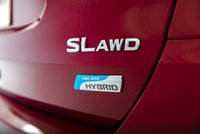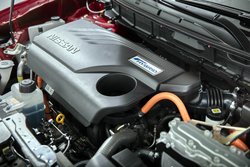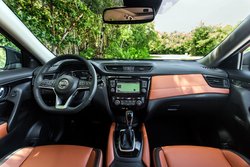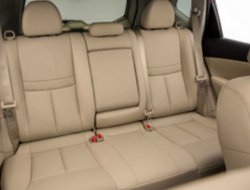A Little Greener Crossover

The Rogue is one very popular Nissan. It’s a compact crossover, so it’s situated in a rising market segment. The most recent version has done so well that for 2017, Nissan gave it a heavy mid-cycle refresh, with some updated styling and new content. Most significantly, welcome the first ever 2017 Nissan Rogue Hybrid.
Up front, the Rogue now wears the corporate front fascia with the signature “V-Motion” grille and revised headlights and daytime running lights. In the rear, you’ll find a new bumper and revised boomerang taillamps. Eye-catching 19-inch rims contribute to the new look.
Ford pioneered the motion-activated tailgate, but in a clear example of keeping up with the Joneses, Nissan now offers one, too. The body structure is enhanced for a quieter ride.
Under the Hood Changes

Toyota RAV4 also offers a hybrid, so this model really isn’t a surprise. Nissan has swapped out the standard 175-horsepower 2.5-liter inline four for a 141-horsepower 2.0-liter four, allied with a 30-kW motor to produce a total of 176 horsepower. It all flows through Nissan’s Xtronic continuously variable transmission (CVT).
The car drives just fine with the hybrid drivetrain, but it felt like it was mostly gas-powered. I did note some moments of EV behavior. There is automatic engine shutoff when idling at stoplights. It also has a “Best MPG” display, so if you’ve been driving carefully through commute traffic or a quiet neighborhood and rack up good numbers, you can replace your previous best.
There’s a small energy flow diagram in the instrument panel, so you can see what the car’s doing and moderate your behavior for maximum efficiency. It has the requisite colorful moving display in the center console, but it’s really more of a distraction. Nissan made it look just different enough from the well-known Toyota display to save on legal fees.
Fuel Economy Up 22%
You can get a 2017 Nissan Rogue, hybrid or not, in S, SV, and SL designations. The Hybrid doesn’t come in the base S level, but you can order it with front- or all-wheel drive. My Palatial Ruby test vehicle was a top-level SL Hybrid with all-wheel drive. That means that the U.S. EPA awarded it ratings of 31 city/34 highway/33 combined, a solid addition to the 30 MPG AWD Club. I averaged 25.6 mpg. The front-wheel drive hybrid model boosts those numbers by 2 mpg city and 1 mpg for the highway and combined scores.

Compare that to the regular gas model. The AWD version, the direct non-hybrid match to my tester, earns 25 city/32 highway/27 combined. So, on paper at least, the hybrid delivers a 22 percent improvement.
Green scores are 7 for Smog and 8 for Greenhouse Gas.
Small, But It Doesn’t Feel That Way

The 2017 Nissan Rogue Hybrid may be a “small SUV,” per the EPA, but it doesn’t feel small inside. You sit up high, and the interior furnishings are first rate. The flowing door and dash create a sensation of movement, and materials show no hint of penny pinching. The carbon fiber trim is faux, but this is a Rogue, after all. There’s a stitched panel on the passenger side of the dashboard above the glovebox, just for effect.
The SL, the top of the line, is packed with goodies you won’t see on the SV unless you check some option boxes. You get the QuickComfort heated front seats, which immediately start warming the body areas most sensitive to heat, such as thighs and hips. There’s a memory setting for the mirrors and driver’s seat, a heated leather steering wheel, a seven-inch color touch-screen display, the NissanConnect navigation system with various apps and a lovely Bose Premium Audio system with nine speakers. That all sounds like stuff worth having, if you can afford the bill.

You get all the Safety Shield protections, such as blind spot warning, rear cross traffic alert and the two forward motion ones—lane departure warning and the more aggressive lane departure prevention. Nissan added two new ones for 2017—Intelligent Cruise Control (adaptive cruise control generically) and forward emergency braking with pedestrian detection. These features make it safer to drive the car and to be walking near it, and are helping to pave the way toward true autonomous driving.
The Rogue is smaller than its Pathfinder sibling, but it still can be ordered with a third-row seat—if you select the standard car. With the Hybrid, the third-row foot room is taken up by battery. The car weighs 3,693 pounds, so this is a beast to be reckoned with.
Pricing ascends from the front-wheel-drive S non-hybrid at $23,820 to the all-wheel-drive SL Hybrid at $32,510 (plus $940 destination and handling charges).
People today want the high-riding crossover SUV experience and are looking for an easy-to-drive, right-sized family car, so the 2017 Nissan Rogue is going to shuttling around a lot of families. The new Hybrid makes that just a little less impactful on the planet.
Related Stories You Might Enjoy:
Road Test: 2016 Toyota RAV4 Hybrid
Road Test: 2016 Nissan Rogue
Top 10 Best MPG AWD SUVs/Crossovers
Road Test: 2016 Ford Escape
Road Test: 2016 Mazda CX-5
Road Test: 2017 Kia Sportage
Road Test: 2016 Honda CR-V
Disclosure:
Clean Fleet Report is loaned free test vehicles from automakers to evaluate, typically for a week at a time. Our road tests are based on this one-week drive of a new vehicle. Because of this we don’t address issues such as long-term reliability or total cost of ownership. In addition we are often invited to manufacturer events highlighting new vehicles or technology. As part of these events we may be offered free transportation, lodging or meals. We do our best to present our unvarnished evaluations of vehicles and news irrespective of these inducements.
Our focus is on vehicles that offer the best fuel economy in their class. We also feature those that are among the top mpg vehicles in their class. In addition, we aim to offer reviews and news on advanced technology and the alternative fuel vehicle market. We welcome any feedback from vehicle owners and are dedicated to providing a forum for alternative viewpoints. Please let us know your views at publisher@cleanfleetreport.com.

9 thoughts on “Road Test: 2017 Nissan Rogue Hybrid”